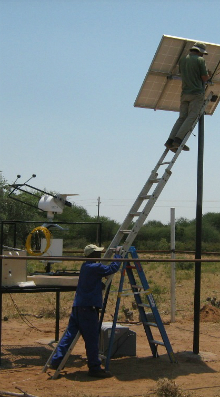In order to meet the remaining 4,000 GWh of the target, the National Energy Regulator of South Africa (NERSA) published in March 2009 a Renewable Energy Feed-In Tarif (REFIT) to encourage investment in developing technologies, as follows:
• Wind: 1.25 ZAR/kWh
• Small hydroelectric: 0.94 ZAR/kWh
• Landfill gas: 0.90 ZAR/kWh
• Concentrating solar: 2.10 ZAR/kWh
In October of 2009 the following additional tariffs were published:
• Concentrated solar power troughs without storage at ZAR 3.14/kWh
• Solid biomass at ZAR 1.18/kWh
• Biogas at ZAR 0.96/kWh
• Photovoltaic systems (large ground or roof mounted) at ZAR 3.96/kWh
• Concentrated solar power (central tower) with 6 hours
• storage at ZAR 2.31/kWh
1 Euro is equal to approximately 9.3 South African Rand (ZAR).
 South Africa has some of the best solar energy resources in the world with locations having an annual sum of Direct Normal Irradiation (DNI) exceeding 2900 kWh/m2 (8000 Wh/m²/d). This, along with the attractive REFIT scheme, has lured many Concentrated Solar Power (CSP) developers to South Africa. A DNI map of South Africa based on satellite derived data from the National Renewable Energy Laboratory (NREL) in the USA is shown at right.
South Africa has some of the best solar energy resources in the world with locations having an annual sum of Direct Normal Irradiation (DNI) exceeding 2900 kWh/m2 (8000 Wh/m²/d). This, along with the attractive REFIT scheme, has lured many Concentrated Solar Power (CSP) developers to South Africa. A DNI map of South Africa based on satellite derived data from the National Renewable Energy Laboratory (NREL) in the USA is shown at right.
The Centre for Renewable and Sustainable Energy Studies (CRSES), situated within the Department of Mechanical and Mechatronic Engineering at Stellenbosch University, has the capability to offer solar resource assessment services to CSP developers. The service includes the specification, installation and operation of a solar measuring station for a minimum period of one year. In addition, satellite-derived data from various sources are compared to the measured ground-level data.
In February 2010 the first solar radiation measurement station was installed. This uses a Kipp & Zonen SOLYS 2 sun tracker, a CHP 1 pyrheliometer, two CMP 6 pyranometers and a Campbell Scientific CR800 data logger to measure direct, diffuse and global solar radiation.
A second station was installed in May, comprising two CMP 6 pyranometers and a CM 121 shadow ring.
The installation was expanded in July 2011 with a CHP 1 pyrheliometer, a SOLYS 2 sun tracker, a Campbell Scientific CR1000 data logger and a 10 m meteorology mast with anemometer, wind vane, temperature, humidity and barometric pressure sensors.
 Both stations are located in Upington; a town in the Northern Cape Province that is known for having high annual DNI sums, due to low rainfall and minimal cloud cover. When it does rain in Upington, it is mainly during the night or in the early morning hours. It was found that, in general, for the Upington area the satellite-derived data under-estimates the measured data. This is good news for CSP developers and the future of solar energy in South Africa.
Both stations are located in Upington; a town in the Northern Cape Province that is known for having high annual DNI sums, due to low rainfall and minimal cloud cover. When it does rain in Upington, it is mainly during the night or in the early morning hours. It was found that, in general, for the Upington area the satellite-derived data under-estimates the measured data. This is good news for CSP developers and the future of solar energy in South Africa.